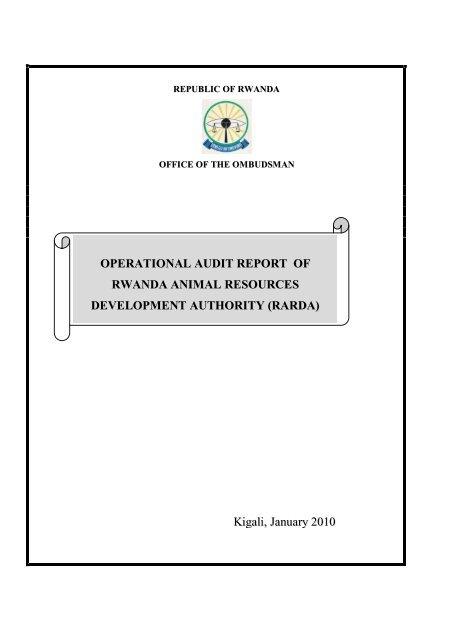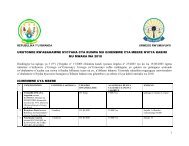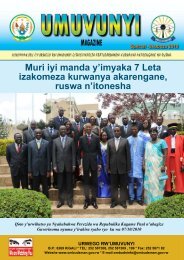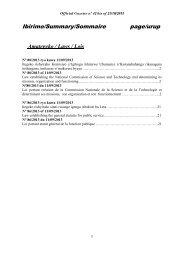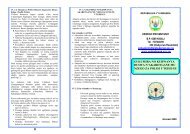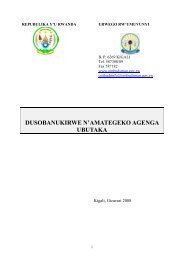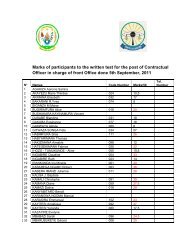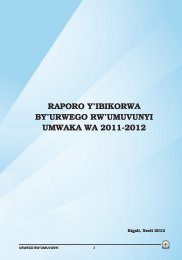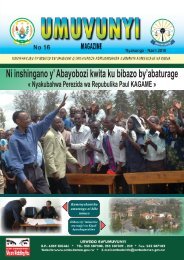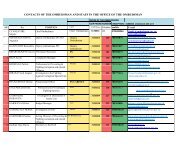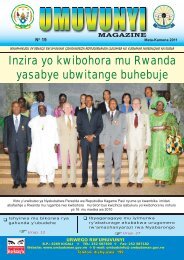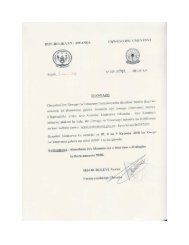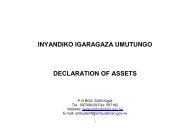rarda - Office of the Ombudsman
rarda - Office of the Ombudsman
rarda - Office of the Ombudsman
Create successful ePaper yourself
Turn your PDF publications into a flip-book with our unique Google optimized e-Paper software.
REPUBLIC OF RWANDA<br />
OFFICE OF THE OMBUDSMAN<br />
OPERATIONAL AUDIT REPORT OF<br />
RWANDA ANIMAL RESOURCES<br />
DEVELOPMENT AUTHORITY (RARDA)<br />
Kigali, January 2010
ii<br />
TABLE OF CONTENT<br />
GLOSSARY OF ABREVIATIONS ..................................................................................... iii<br />
EXECUTIVE SUMMARY ....................................................................................................1<br />
I. CONTEXT OF OPERATIONAL AUDIT ...........................................................................2<br />
I. 1. Mission <strong>of</strong> <strong>the</strong> <strong>Office</strong> <strong>of</strong> <strong>the</strong> <strong>Ombudsman</strong>.....................................................................2<br />
I. 2. General presentation <strong>of</strong> RARDA .................................................................................3<br />
1.2.1. Responsibilities .....................................................................................................3<br />
1.2.2. Mission .................................................................................................................4<br />
1.2.3. Strategies ..............................................................................................................4<br />
I. 3. Methodology ...............................................................................................................5<br />
II. FINDINGS ........................................................................................................................6<br />
II.1 Transparency ................................................................................................................6<br />
II. 2. Accountability ............................................................................................................6<br />
II.3. Proper administration ..................................................................................................6<br />
II.4 Efficiency ....................................................................................................................8<br />
II.4.1. Organisational structure ........................................................................................8<br />
II.4.2. Strategic and action plans .....................................................................................9<br />
II.4.3. Budget ................................................................................................................ 10<br />
II.4.5. Procurement process ........................................................................................... 11<br />
II.4.6. Management systems .......................................................................................... 12<br />
II.4.7. Internal audit ...................................................................................................... 14<br />
II.4.8. Recovery process ................................................................................................ 14<br />
II. 5. effectiveness ............................................................................................................. 15<br />
II.5.1. Genetic improvement ......................................................................................... 15<br />
II.5.2. Poultry production .............................................................................................. 16<br />
II.5.3. One cow per poor family project ......................................................................... 16<br />
II.5.4. Veterinary services ............................................................................................. 18<br />
III. SWOT ANALYSIS ........................................................................................................ 20<br />
IV. RECOMMENDATIONS ................................................................................................ 22<br />
VI. CONCLUSION .............................................................................................................. 22
iii<br />
GLOSSARY OF ABREVIATIONS<br />
CNIA<br />
: Centre for Artificial Insemination;<br />
EICV : Enquête Intégrale des Conditions de Vie des Ménages ;<br />
EPR : Eglise Protestante du Rwanda ;<br />
DCDP : Decentralization and Community Development Project ;<br />
FRw : Francs Rwandais ;<br />
ISAE<br />
: Institut Supérieure d’Agronomie et de l’Elevage;<br />
IRST : Institute <strong>of</strong> Scientific and Technological Research ;<br />
LWF<br />
: Lu<strong>the</strong>rian World Federation;<br />
MINAGRI : Ministère de l’Agriculture et des Ressources Animales ;<br />
NGO : Non Governmental Organization;<br />
OIE : Organisation Internationale de l’Elevage ;<br />
PADEBL : Projet d’Appui au Développement de l’Elevage Bovin<br />
Laitier ;<br />
PAIGELAC : Projet d’Appui à l’Aménagement Intégré et à la Gestion<br />
des Lacs Intérieurs ;<br />
PRSP : Poverty Reduction Strategy Program;<br />
RARDA : Rwanda Animal Resources Development Authority ;<br />
RBS<br />
RSSP<br />
SWOT<br />
WAHIS<br />
: Rwanda Bureau <strong>of</strong> Standards<br />
: Rural Sector Support Project;<br />
: Strengths, Weaknesses, Opportunities, Threats;<br />
: World Animal Health Information System.
1<br />
EXECUTIVE SUMMARY<br />
To implement its responsibilities <strong>of</strong> advising public and private institutions as to improving<br />
<strong>the</strong> quality <strong>of</strong> services delivered to <strong>the</strong> population and <strong>of</strong> preventing and fighting injustice,<br />
corruption and o<strong>the</strong>r related <strong>of</strong>fences in public and private administration, <strong>the</strong> <strong>Office</strong> <strong>of</strong> <strong>the</strong><br />
<strong>Ombudsman</strong> conducted an operational audit on <strong>the</strong> functioning <strong>of</strong> Rwanda Animal Resources<br />
Development Authority.<br />
This report contains findings and inefficiencies in <strong>the</strong> management and operations <strong>of</strong><br />
RARDA, a SWOT analysis and recommendations provided to improve <strong>the</strong> functioning.<br />
The purpose <strong>of</strong> <strong>the</strong> audit was to evaluate how RARDA achieves <strong>the</strong> objectives in relation with<br />
its mission and vision.<br />
RARDA has good working relations with partners. Due to <strong>the</strong> strategy <strong>of</strong> decentralisation;<br />
with <strong>the</strong> presence <strong>of</strong> veterinary staff at sector level, establishment <strong>of</strong> satellites laboratories <strong>the</strong><br />
delivery services has improved by <strong>of</strong>fering extension services to <strong>the</strong> population.<br />
RARDA is carrying out activities related to <strong>the</strong> genetic improvement by training inseminators,<br />
<strong>the</strong>ir number came from 19 in 2005 to 501 in 2008. In collaboration with <strong>the</strong> local<br />
government, RARDA plans vaccinations campaigns against epidemics, it has set up<br />
quarantines posts at borders, it is carrying regular epidemic surveillance for major animal<br />
diseases. From 2008 RARDA laboratory <strong>of</strong> semen production started to produce semen and<br />
this has reduced on <strong>the</strong> reliance on imported semen that is expensive.<br />
However, constraints remain as a barrier to animal resources development, some are relating<br />
to <strong>the</strong> illiteracy <strong>of</strong> <strong>the</strong> majority <strong>of</strong> farmers, absence <strong>of</strong> strategies on animal nutrition, high<br />
costs <strong>of</strong> imported feeds and old machine in <strong>the</strong> hatchery.<br />
It was noticed that RARDA faces some constraints and barrier which are considered as<br />
obstacle in its functioning. Some <strong>of</strong> <strong>the</strong>m consist on a limited number in human resources,<br />
number <strong>of</strong> veterinaries on sector level that are getting paid once in 6 months, poor planning<br />
procurement, delays in recovery credits <strong>of</strong> vaccines and <strong>the</strong> absence <strong>of</strong> ear tags and<br />
identification system for purposes <strong>of</strong> preventing epidemics.
2<br />
In order to improve its functioning, some recommendations are given to reinforce <strong>the</strong> internal<br />
system <strong>of</strong> control, and <strong>the</strong>n strenghten <strong>the</strong> sector to be self sufficient in food <strong>of</strong> animal origin<br />
and have a surplus for sale.<br />
I. CONTEXT OF OPERATIONAL AUDIT<br />
This part will deal with <strong>the</strong> mission <strong>of</strong> <strong>the</strong> <strong>Office</strong> <strong>of</strong> <strong>the</strong> <strong>Ombudsman</strong>, presentation <strong>of</strong> <strong>the</strong><br />
visited institution and <strong>the</strong> methodology used in <strong>the</strong> operational audit.<br />
I. 1. Mission <strong>of</strong> <strong>the</strong> <strong>Office</strong> <strong>of</strong> <strong>the</strong> <strong>Ombudsman</strong><br />
Article 7 <strong>of</strong> <strong>the</strong> law n°25/2003 <strong>of</strong> 17/2005 establishing <strong>the</strong> <strong>Office</strong> <strong>of</strong> <strong>Ombudsman</strong> provides<br />
various attributions and some <strong>of</strong> <strong>the</strong>m include <strong>the</strong> following:<br />
- acting as a link between citizen , public and private institutions;<br />
- preventing and fighting injustice, corruption and o<strong>the</strong>r related <strong>of</strong>fences in public and<br />
private administration;<br />
- advising cabinet and o<strong>the</strong>r concerned institutions as regards streng<strong>the</strong>ning and<br />
improving <strong>the</strong>ir policy <strong>of</strong> preventing, fighting and punishing corruption and o<strong>the</strong>r related<br />
<strong>of</strong>fences;<br />
- advising public and private institutions as to improving <strong>the</strong> quality <strong>of</strong> services delivered<br />
to <strong>the</strong> population.<br />
In order to carry out <strong>the</strong> above assigned attributions, <strong>the</strong> <strong>Office</strong> <strong>of</strong> <strong>the</strong> <strong>Ombudsman</strong>, based on<br />
its action plan, evaluated <strong>the</strong> functioning <strong>of</strong> <strong>the</strong> RARDA from 28 th August to 18 th September<br />
2009. The main objectives <strong>of</strong> that evaluation exercise was:<br />
- to examine <strong>the</strong> current structure <strong>of</strong> RARDA;<br />
- to examine leadership, functionning <strong>of</strong> <strong>the</strong> company;<br />
- to examine company’s policies, Procedures, manuals in relation to <strong>the</strong> above are<br />
appropriate and complied with;<br />
- to examine <strong>the</strong> quality <strong>of</strong> service delivered;<br />
- to examine whe<strong>the</strong>r functioning and daily routine <strong>of</strong> RARDA respects principles <strong>of</strong><br />
good governance and if it does not give loopholes <strong>of</strong> corruption and injustice.
3<br />
I. 2. General presentation <strong>of</strong> RARDA<br />
RARDA has been established by <strong>the</strong> low n°41/2006 <strong>of</strong> 30/09/2006 determining <strong>the</strong><br />
responsibilities, <strong>the</strong> functioning <strong>of</strong> Rwanda Animal Resources Development Authority.<br />
RARDA has legal personality, administrative and financial autonomy.<br />
1.2.1. Responsibilities<br />
RARDA has <strong>the</strong> following responsibilities:<br />
- to implement <strong>the</strong> national policy for animal resources development;<br />
- to provide stockbreeders and consumers <strong>of</strong> animal products with information,<br />
techniques and services meant for improving <strong>the</strong>ir pr<strong>of</strong>ession and supplying <strong>the</strong><br />
market with increased produce and raising incomes;<br />
- to provide stockbreeders and individuals dealing with animal production with<br />
knowledge and technologies meant for value added animal products, to play a role in<br />
storage activities and market for animal products;<br />
- to control animal diseases and implement appropriate strategies meant for ensuring<br />
prevention, protection, diagnosis and treatment <strong>of</strong> animal diseases and particularly<br />
zoonosis;<br />
- to coordinate activities <strong>of</strong> stockbreeders and individuals dealing with animal<br />
production;<br />
- to build stockbreeders’ capacity so as to allow <strong>the</strong>m play <strong>the</strong>ir role in <strong>the</strong>ir pr<strong>of</strong>ession<br />
improvement and country’s development;<br />
- to coordinate all animal production related activities so as to ensure <strong>the</strong>ir<br />
complementarity;<br />
- to collect and publicize statistics and information linked with animal diseases and<br />
production at <strong>the</strong> national level;<br />
- to assist Rwanda Government in implementing laws and regulations governing animal<br />
resources and animal products;<br />
- to establish relation and collaborate with o<strong>the</strong>r regional and international authorities<br />
with <strong>the</strong> same mission.
4<br />
1.2.2. Mission<br />
The mission <strong>of</strong> <strong>the</strong> Rwanda Animal Resources Development Authority (RARDA) is to<br />
contribute towards <strong>the</strong> growth <strong>of</strong> animal production through <strong>the</strong> development <strong>of</strong> appropriate<br />
technologies, providing advisory, outreach and extension services to stakeholders in <strong>the</strong><br />
animal resources sector including provinces, districts, NGOs, farmers and farmer’s<br />
organizations, to allow <strong>the</strong>m to modernize <strong>the</strong> sector in <strong>the</strong> framework provided by <strong>the</strong><br />
national policy, PRSP, <strong>the</strong> vision 2020.<br />
1.2.3. Strategies<br />
RARDA approaches its tasks through different means. The first one is following <strong>the</strong> strategy<br />
<strong>of</strong> decentralization. The government <strong>of</strong> Rwanda has adopted a decentralization policy aiming<br />
at bringing services close to <strong>the</strong> population. According to this policy <strong>the</strong> Umurenge is going to<br />
be <strong>the</strong> focal unit for development. The services rendered will target an improved delivery at<br />
Umurenge level. This is done with <strong>the</strong> local staff <strong>of</strong> <strong>the</strong> respective districts. The control <strong>of</strong><br />
animal disease in <strong>the</strong> country will address <strong>the</strong> control <strong>of</strong> epidemic diseases and pests.<br />
RARDA’s current strategic plan will focus on programmed vaccinations against major<br />
epidemics, establishment <strong>of</strong> stock routes, check points along highways and established<br />
quarantine posts at <strong>the</strong> borders <strong>of</strong> this country. The control will also involve carrying out<br />
regular epidemio-surveillance for <strong>the</strong> major diseases in <strong>the</strong> country.<br />
Working with decentralized local governments and operating in <strong>the</strong> major milk basins and<br />
streng<strong>the</strong>ning <strong>the</strong> capacity <strong>of</strong> <strong>the</strong> national and regional laboratories, educating farmers will<br />
form a basic ingredient <strong>of</strong> <strong>the</strong> strategy.<br />
With <strong>the</strong> presence <strong>of</strong> veterinary staff at Umurenge level, <strong>the</strong> delivery <strong>of</strong> services will improve<br />
as <strong>the</strong> staff will be able to <strong>of</strong>fer extension services to <strong>the</strong> population more effectively. The<br />
services <strong>of</strong>fered will be decentralized. There are satellite laboratories in <strong>the</strong> Sou<strong>the</strong>rn<br />
Province, <strong>the</strong> Western Province and two in <strong>the</strong> Eastern Province capable <strong>of</strong> doing diagnostic<br />
and curative work.
5<br />
I. 3. Methodology<br />
In <strong>the</strong> accordance with <strong>the</strong> objective above, we carried out an operational audit, considered<br />
necessary to ensure that good governance was done in conformity with rules and procedures<br />
in place, and to ensure that <strong>the</strong>re is transparency in <strong>the</strong> daily activities <strong>of</strong> RARDA.<br />
In carrying out <strong>the</strong> operational audit, different documents were sufficiently and appropriately<br />
examined on test basis, and also obtained explanations and information from <strong>the</strong> appropriate<br />
person we deemed necessary to give reliable and relevant explanation and information to be<br />
able to express our evaluation view.<br />
Examined documents are <strong>the</strong> following:<br />
- law governing RARDA;<br />
- action and strategic plans ;<br />
- activities reports from various units;<br />
- organic structure.<br />
During this evaluation exercise, we met <strong>the</strong> following:<br />
- board <strong>of</strong> directors;<br />
- director general;<br />
- directors <strong>of</strong> different units;<br />
- several employees <strong>of</strong> RARDA.<br />
Satellite laboratories in <strong>the</strong> Sou<strong>the</strong>rn Province (Huye), <strong>the</strong> Western Province (Gishwati) and<br />
in <strong>the</strong> Eastern Province (Nyagatare) have been visited in order to be sure <strong>of</strong> how <strong>the</strong>y are<br />
operating.<br />
After ga<strong>the</strong>ring all information, an analysis has been made, and some recommendations are<br />
given to RARDA in order to perfom better.<br />
Besides <strong>the</strong> context and <strong>the</strong> executive summary seen above, this report is composed <strong>of</strong><br />
findings, Swot analysis, recommendations and conclusion.
6<br />
II. FINDINGS<br />
This part <strong>of</strong> report analyses if RARDA in carrying out its attributions respects <strong>the</strong> major<br />
elements <strong>of</strong> good governance.<br />
II.1 Transparency<br />
The decisions taken and <strong>the</strong>ir enforcement are done in manner that follows rules and<br />
regulations.<br />
RARDA has established many instructions and regulations which guide it in its functioning.<br />
Some <strong>of</strong> <strong>the</strong>m are <strong>the</strong> following:<br />
II. 2. Accountability<br />
RARDA has a website on which it publishes its activities and services. RARDA contributes<br />
towards <strong>the</strong> growth <strong>of</strong> animal production through <strong>the</strong> development <strong>of</strong> appropriate<br />
technologies, providing advisory, outreach and extension services to stakeholders in <strong>the</strong><br />
animal resources sector.<br />
RARDA has improved <strong>the</strong> delivery <strong>of</strong> services with <strong>the</strong> presence <strong>of</strong> veterinary staff at all<br />
sector level in order to <strong>of</strong>fer extension services to <strong>the</strong> population more effectively.<br />
II.3. Proper administration<br />
As by <strong>the</strong> principle <strong>of</strong> legality, RARDA has so many instructions and regulations as said<br />
above, in which it shows rights and obligations <strong>of</strong> employees and employer and <strong>the</strong> conditions<br />
to fulfil in order to take a decision.<br />
RARDA has good working relations with partners; those are projects, ONG and different<br />
organizations operating in different districts; into different areas as extension, research,<br />
genetic improvement, animal health. Some <strong>of</strong> <strong>the</strong>m are mentioned on <strong>the</strong> table below:
7<br />
Table n°1: Organizations partners to RARDA<br />
Organization Type <strong>of</strong> service Partnership with RARDA<br />
HPI<br />
Genetic Improvement in<br />
Byumba, Ruhengeri, Kigali<br />
Ngali<br />
Train Inseminators working in <strong>the</strong>ir operation<br />
area Provision <strong>of</strong> Insemination kits Provision<br />
<strong>of</strong> liquid nitrogen<br />
PDRCIU<br />
Animal husbandry in Train Inseminators working in <strong>the</strong>ir operation<br />
Umutara<br />
area<br />
ARMV Vaccination Provision <strong>of</strong> vaccines<br />
Train Inseminators working in <strong>the</strong>ir operation<br />
GAHINI DIOCESE Animal husbandry<br />
area Provision <strong>of</strong> Insemination kits Provision<br />
<strong>of</strong> liquid nitrogen Extension to farmers<br />
SEND A COW<br />
Provision <strong>of</strong> Insemination kits<br />
Genetic Improvement in<br />
Provision <strong>of</strong> liquid nitrogen<br />
Buliza Kabuga<br />
Provision <strong>of</strong> Semen and Hormones<br />
IAR Extension Building capacity<br />
ISAR Research Train Inseminators Pasture improvement<br />
ISAE Training and Research Joint student research supervision<br />
LWF Extension Gitarama Train farmers in <strong>the</strong>ir operation area<br />
EPR Extension Kigali Train farmers in <strong>the</strong>ir operation area<br />
INGABO<br />
Genetic Improvement in<br />
Gitarama<br />
Provide AI kits Train inseminators<br />
DUHAMIC ADRI<br />
Genetic Improvement in<br />
Kigali Ngali<br />
Provide AI kits Train inseminators<br />
IRST Animal health Use <strong>of</strong> traditional medicine<br />
BAIR<br />
Genetic Improvement in<br />
Gisenyi<br />
Provide AI kits Train inseminators<br />
HPI<br />
Genetic Improvement in<br />
Byumba, Ruhengeri, Kigali<br />
Ngali<br />
Train Inseminators working in <strong>the</strong>ir operation<br />
area Provision <strong>of</strong> Insemination kits Provision<br />
<strong>of</strong> liquid nitrogen<br />
PDRCIU<br />
Animal husbandry in Train Inseminators working in <strong>the</strong>ir operation<br />
Umutara<br />
area<br />
ARMV Vaccination Provision <strong>of</strong> vaccines
8<br />
II.4 Efficiency<br />
To be efficient, <strong>the</strong> institution must make <strong>the</strong> best use <strong>of</strong> resources at its disposal. This part<br />
will mainly focus on organisational structure, strategic and action plans, management system,<br />
assets management budget and procurement process and <strong>the</strong> internal audit.<br />
II.4.1. Organisational structure<br />
Chart n° 1: Organizational structure <strong>of</strong> RARDA<br />
MINAGRI<br />
Board <strong>of</strong> Directors<br />
Director<br />
Administration &<br />
Finance Unit<br />
-Central Secretariat<br />
- Human Resources<br />
Management<br />
- Accountant<br />
- Logistics<br />
- ICT<br />
- Procurement<br />
- Extensionist<br />
- Maintenance<br />
Veterinary services<br />
Unit<br />
- Protozoology<br />
- Entomology<br />
- Helminthology<br />
- Microbiology<br />
- Epidemiology<br />
- Satellite Laboratory<br />
- Control and quarantin<br />
posts<br />
- Inspection, Control <strong>of</strong><br />
products used in<br />
animal husbandry and<br />
cetification <strong>of</strong> markets<br />
- Regional Veterinary<br />
Services<br />
- Veterinqry store<br />
Animal Production<br />
- Semen Production<br />
- Artificial Insemination<br />
- Bovine genetic<br />
Improvement<br />
- Small Animals and<br />
Restocking<br />
programm<br />
- Fish and Fish Farming<br />
- Animal feeding<br />
- Processing <strong>of</strong> Animal<br />
products<br />
- Infrastucture <strong>of</strong> Adding<br />
value
9<br />
As it is shown in <strong>the</strong> organizational chart above, RARDA is supervised by <strong>the</strong> Ministry in<br />
charge <strong>of</strong> Animal resources development. It comprises two administrative organs: Board <strong>of</strong><br />
directors and <strong>the</strong> Management.<br />
Daily activities <strong>of</strong> <strong>the</strong> RARDA are carried out in its two technical units: Veterinary services<br />
unit and animal production unit.<br />
The One cow per poor family program has a coordinator and <strong>the</strong> coordination unit. This<br />
program started in 2006 after <strong>the</strong> structure <strong>of</strong> RARDA had been accepted by cabinet.<br />
RARDA representatives in province and satellite laboratories are under <strong>the</strong> veterinary services<br />
unit.<br />
II.4.2. Strategic and action plans<br />
RARDA has elaborated a business plan that targets to increase meat, milk, eggs, honey, fish<br />
hides and skins in <strong>the</strong> country.<br />
It focuses to <strong>the</strong> following priority programs:<br />
disease control<br />
Genetic improvement<br />
Fishery and fish farming<br />
Animal products upgrading<br />
Animal nutrition<br />
Modern animal husbandry<br />
Bee keeping<br />
With <strong>the</strong> implementation <strong>of</strong> <strong>the</strong> plan, <strong>the</strong> main objective is to increase products <strong>of</strong> animal<br />
origin, importation <strong>of</strong> <strong>the</strong>se products so that <strong>the</strong> importation <strong>of</strong> those products will be no<br />
longer necessary.<br />
For <strong>the</strong> success <strong>of</strong> <strong>the</strong>se programs, RARDA works closely with its key partners namely:<br />
- Farmers and farmers association;<br />
- Local government authorities;<br />
- Extention workers in animal resources;<br />
- Reseachers and consultants in animal resources;<br />
- Investors and innovators in animal resources
10<br />
According to <strong>the</strong> 2008 activities report, <strong>the</strong> action plan 2008 was successfully implemented,<br />
however <strong>the</strong>re are weaknesses in some areas as follows:<br />
- <strong>the</strong> herd book program : (activity related to <strong>the</strong> registration after indentification <strong>of</strong><br />
cattles). Statistics <strong>of</strong> cattles registered in <strong>the</strong> appropriate s<strong>of</strong>tware are still very low, out<br />
<strong>of</strong> 50.000 cows inseminated , only 2.051 are registered by december 2008 (4,1%).<br />
The problem is due to <strong>the</strong> obsolete s<strong>of</strong>tware, which doen’t enable inseminators a direct<br />
registration <strong>of</strong> cattle inseminated in <strong>the</strong> s<strong>of</strong>tware.<br />
- <strong>the</strong> training <strong>of</strong> farmers in storage <strong>of</strong> cattle herbs 380 famers have been trained in 2008;<br />
- <strong>the</strong> training <strong>of</strong> animal nutritive concentrate, in 2008, 10 persons have been trained out <strong>of</strong><br />
15.<br />
Apart from <strong>the</strong> business plan, RARDA has established many strategies which enable to work<br />
effectively, some <strong>of</strong> <strong>the</strong>m are:<br />
- national emergency plan for <strong>the</strong> prevention and response against avian infuenza in<br />
Rwanda ;<br />
- strategies against animals diseases in Rwanda ;<br />
- milk inspection in Rwanda ;<br />
- national program for rice production : period : 2006-2016 ;<br />
- guide <strong>of</strong> distribution a cow to every poor family in Rwanda ;<br />
- list <strong>of</strong> products and items used in agriculture and animal resources to be exonerated;<br />
- different Ministerial instructions are put in place to regulate animal farming in<br />
Rwanda.<br />
II.4.3. Budget<br />
RARDA annual budget is allocated by <strong>the</strong> Government. It benefits sometimes donors’funds.<br />
The table below shows <strong>the</strong> budget granted and <strong>the</strong> one spent in 2007 and 2008.<br />
Table n°2: Revenue and expenditure <strong>of</strong> RARDA <strong>of</strong> 2007-2008<br />
Title 2007 2008<br />
Budget granted 1.848.134.508 2.565.114.782<br />
Grants from donors 55.631.383 148.620.137<br />
O<strong>the</strong>r income 243.522.627 346.639.890<br />
Expenses 1.672.407.436 2.555.732.865
11<br />
Chart n°2: Revenue and expenditure <strong>of</strong> RARDA <strong>of</strong> 2007-2008<br />
3000000000<br />
2500000000<br />
2000000000<br />
1500000000<br />
2007<br />
2008<br />
1000000000<br />
500000000<br />
0<br />
Budget granted<br />
Grants from<br />
donors<br />
O<strong>the</strong>r income<br />
Expenses<br />
According to <strong>the</strong> table above, in general, RARDA budget has increased from 2007-2009.<br />
Grants from donors, have also increased as well as o<strong>the</strong>r income, which includes internally<br />
generated income, receipt from sales <strong>of</strong> barbed wire, cans for milk, vaccines, ear tags, eggs,<br />
chicks, chickens, semen, nitrogen and tender documents.<br />
II.4.5. Procurement process<br />
RARDA has an internal tender committee composed <strong>of</strong> four persons. In general, tenders<br />
documents are well filed, but some weknesses <strong>of</strong> non compliance with public procurement<br />
procedures have been found out:<br />
- poor procurement planning : tenders awarded in 2008 exceeded tenders that were<br />
planned to 62,3% and it was repeated in tender awarded in january up to june 2009<br />
where <strong>the</strong> planned tenders excceded and by june it has been awarded 30%:<br />
- in 2008, <strong>the</strong>re was 52 tenderes planned, but 138 were executed<br />
- in 2009, by June, 59 tenders were executed whereas 37 were planned on <strong>the</strong> whole<br />
year.<br />
- many tenders using single sources, this doesn’t enable RARDA to benefit <strong>of</strong><br />
purchasing goods and services <strong>of</strong> high quality at prices that are competitive.<br />
Some <strong>of</strong> those tenders are <strong>the</strong> following:<br />
<strong>the</strong> tender <strong>of</strong> supply <strong>of</strong> hormones and artificial insemination materials for<br />
RARDA-MINAGRI attributed to Veterinary Import Authority to amount <strong>of</strong><br />
20,727.40$ whereas in <strong>the</strong> evaluation report <strong>of</strong> internal tender committee<br />
AGROTECH was <strong>the</strong> winner <strong>of</strong> this tender;
12<br />
<strong>the</strong> tender n°162/08 <strong>of</strong> 26 th February 2008 attributed to AFRICHEM where<br />
RARDA use <strong>the</strong> solicitation <strong>of</strong> quotation method for <strong>the</strong> cost <strong>of</strong> 7,545,751 frw;<br />
tender <strong>of</strong> purchasing kind <strong>of</strong> food attributed to SOPROFA (Société pour la<br />
Promotion de Filières Agricoles) to an amount <strong>of</strong> 5,303,200 frws using<br />
solicitation <strong>of</strong> quotation method (see <strong>the</strong> contract n°613/RARDA/2009);<br />
tender for 80.000 doses <strong>of</strong> FMD Vaccines ref 032/09/RARDA attributed to<br />
KEVEVAPI <strong>of</strong> Nairobi to <strong>the</strong> amount <strong>of</strong> 82 500 $ on 27 th April 2009 using single<br />
Source method;<br />
Tender for FMD vaccines acquisition de vaccine “contre la fièvre aphteuse”<br />
reference 032/09/RARDA attributed to KEVEVAPI <strong>of</strong> Nairobi ref<br />
025/f/RARDA/209 to <strong>the</strong> amount <strong>of</strong> 82 500$ on 16 th much 2009 using single<br />
source method;<br />
Tender awarded to KEVEVAPI <strong>of</strong> Nairobi on 28 th January 2008 to <strong>the</strong> amount <strong>of</strong><br />
62,000 $ CIF using also single source method;<br />
Tender <strong>of</strong> purchasing 5000 dose <strong>of</strong> frizone semen attributed to SEMEX Alliance to<br />
amount <strong>of</strong> 19,416$ Canadians using credit letter to <strong>the</strong> account n°1201173 <strong>of</strong><br />
RARDA in BNR.<br />
II.4.6. Management systems<br />
This parts emphasis about <strong>the</strong> functioning <strong>of</strong> <strong>the</strong> board <strong>of</strong> director and <strong>the</strong> management.<br />
a) The Board <strong>of</strong> directors<br />
The Board <strong>of</strong> Directors <strong>of</strong> RARDA is composed <strong>of</strong> 7 members. It has signed a performance<br />
contract with MINAGRI which indicates powers, rights and responsibilities <strong>of</strong> each party in<br />
fulfilling <strong>the</strong> responsibilities <strong>of</strong> RARDA.<br />
The Board <strong>of</strong> directors holds meetings in accordance <strong>of</strong> article 9 <strong>of</strong> law n°41/2006. In 2008,<br />
<strong>the</strong> Board <strong>of</strong> directors held 4 sessions against 4 sessions by August in 2008. The minutes <strong>of</strong><br />
meeting are available and filed well.<br />
It was found out that <strong>the</strong> chairperson <strong>of</strong> <strong>the</strong> board <strong>of</strong> directors has been absent for 3 years and<br />
still now was not yet replaced.
13<br />
The Board <strong>of</strong> Directors <strong>of</strong> RARDA is <strong>the</strong> highest decision taking body. In that respect, it has<br />
full powers and responsibilities on <strong>the</strong> management <strong>of</strong> <strong>the</strong> institution, but <strong>the</strong> atmosphere with<br />
<strong>the</strong> management is not fine. This is expressed in working collaboration between <strong>the</strong> RARDA<br />
Director and <strong>the</strong> Acting Chairman <strong>of</strong> <strong>the</strong> Board.<br />
Here are some examples:<br />
- <strong>the</strong> director leaves for foreign mission without informing <strong>the</strong> chairman <strong>of</strong> <strong>the</strong> Board;<br />
- contradictory correspondence from <strong>the</strong> board <strong>of</strong> directors and management sent to <strong>the</strong><br />
Ministry <strong>of</strong> agriculture about restructuring at <strong>the</strong> heads <strong>of</strong> units level;<br />
b) Management team<br />
The management team is composed <strong>of</strong> <strong>the</strong> Directors, heads <strong>of</strong> <strong>the</strong> units as well as <strong>the</strong><br />
coordinator <strong>of</strong> one cow per poor family program.<br />
Management meetings are held every Monday. Minutes are produced, approved, signed and<br />
filed; however <strong>the</strong>re is no channel to communicate decisions to o<strong>the</strong>r employees.<br />
The management meetings mostly examine and exchange views on <strong>the</strong> evolution <strong>of</strong> activities<br />
in various units and <strong>the</strong> planning <strong>of</strong> future activities.<br />
From its creation, RARDA <strong>of</strong>fices are not connected to internet, however <strong>the</strong> board <strong>of</strong><br />
directors has requested <strong>the</strong> internet connection to all staff in 2007, actually <strong>the</strong> tender was<br />
given but <strong>the</strong> winner failed to deliver and this will be repeated an will be awarded.<br />
c) Human resource management<br />
RARDA has 58 permanent employees, 11 vacancies and 6 suspended not yet replaced. The<br />
administration unit is in charge <strong>of</strong> human resource management. This unit deals with<br />
personnel files management, salaries and o<strong>the</strong>r employees’ allowances, as well as daily<br />
management <strong>of</strong> personnel.<br />
RARDA has a case <strong>of</strong> 5 employees who have been suspended temporally on 15/10/2008 due<br />
to <strong>the</strong> mismanagement and conflicts in “one cow per poor families program”. After appealing<br />
in <strong>the</strong> Commission <strong>of</strong> Public labour, <strong>the</strong> Commission requests to RARDA <strong>the</strong> reintegration <strong>of</strong><br />
<strong>the</strong> said employees, as stipulated by law n° 22/2002 <strong>of</strong> 09/07/2002 on General statues for<br />
Rwanda Public Services, in article 65, paragraph 2 that “<strong>the</strong> period for suspension for duties<br />
can not exceed six months. The RARDA didn’t reintegrate <strong>the</strong>m, nor did it take a relevant<br />
decision. The commission requested reintegration <strong>of</strong> 2 employers but <strong>the</strong> board requested that<br />
this matter be put on hold till <strong>the</strong> courts <strong>of</strong> law decide on <strong>the</strong> case.
14<br />
II.4.7. Internal audit<br />
Rwanda Animal Resource development Authority has an internal auditor. Internal audit<br />
regularly intervenes in examining forms <strong>of</strong> request for funds and movements <strong>of</strong> receipts in<br />
various counters, but o<strong>the</strong>r services as control post, satellite laboratory and o<strong>the</strong>r service in<br />
province are not audited. Internal auditor reports recommendations are implemented.<br />
II.4.8. Recovery process<br />
RARDA has a big amount <strong>of</strong> debts in districts worth 252.726.900 Frw and has stepped up <strong>the</strong><br />
gear <strong>of</strong> debt recovery toge<strong>the</strong>r with MINALOC. The table below highlights districts and<br />
amounts to be paid.<br />
Table n°3: Debits due to RARDA<br />
DISTRICT<br />
Amount (FRW)<br />
Gatsibo 43.750.000<br />
Nyagatare 93.985.000<br />
Kayonza 22.050.000<br />
Gicumbi 11.030.000<br />
Musanze 2.800.000<br />
Muhanga 1.300.000<br />
Gatsibo 4.650.000<br />
Nyagatare 2.760.000<br />
Ngoma 2.597.300<br />
Rubavu 1.477.050<br />
Nyabihu 2.188.300<br />
Kirehe 6.654.900<br />
Nyagatare 18.700.950<br />
Gatsibo 17.639.750<br />
Kayonza 2.940.150<br />
Bugesera 3.000.000<br />
Huye 990.000<br />
Karongi 200.000<br />
Kayonza (FAO) 6.400.000<br />
Kirehe (FAO) 2.500.000<br />
Nyamasheke 4.400.000
15<br />
DISTRICT<br />
Amount (FRW)<br />
Ruhango 520.000<br />
Rubavu (Rwabuzisoni Léo) 180.000<br />
TOTAL 252.726.900<br />
In a letter dated on 20/08/2009, RARDA requested to MINAGRI for facilitation and support<br />
in recovery process. These debts are due to vaccines and ear tags for cattle identification<br />
supplied to farmers in preventing epidemics.<br />
II. 5. EFFECTIVENESS<br />
Effectiveness is a measure <strong>of</strong> <strong>the</strong> extent to which an institution achieves its objectives as well<br />
as <strong>the</strong> manner in which it interacts and works with o<strong>the</strong>rs in achieving <strong>the</strong>m.<br />
II.5.1. Genetic improvement<br />
The animal production unit addresses issues related to poor genetic material in <strong>the</strong> country.<br />
The local, traditional breeds are less productive than <strong>the</strong>ir exotic counterparts. Therefore, help<br />
in bringing different breeds and improve <strong>the</strong> traditional ones through crosses between <strong>the</strong><br />
indigenous animals with exotic ones.<br />
This is done due to <strong>the</strong> use <strong>of</strong> modern technology to spread good genetic material, train<br />
inseminators and production <strong>of</strong> semen.<br />
The table below highlights <strong>the</strong> increasing <strong>of</strong> number <strong>of</strong> inseminators trained and doses <strong>of</strong><br />
semen produced from 2005 - 2008.<br />
Table n°4: Number <strong>of</strong> inseminators trained and doses <strong>of</strong> semen produced<br />
2005 2006 2007 2008 2009<br />
Number <strong>of</strong> trained inseminators 19 103 267 476 501 1<br />
Dose <strong>of</strong> semen produced - - - 38.000<br />
In artificial insemination program, it seems that number <strong>of</strong> inseminators trained has increased,<br />
however quantity <strong>of</strong> doses <strong>of</strong> semen produced is still very low. According to RARDA<br />
1 Datas <strong>of</strong> inseminators trained by September 2009
16<br />
explanations, <strong>the</strong>re is a lack or insufficiency <strong>of</strong> liquid nitrogen, because <strong>of</strong> machine which<br />
produce liquid nitrogen are obsolete and in bad conditions.<br />
The quantity produced is very low: 38.000 doses in 2008 compared to <strong>the</strong> consumer demand<br />
estimated which is between 60.000 and 100.000 doses per year.<br />
Inseminators have been trained, at least one inseminator in <strong>the</strong> sector, but <strong>the</strong>re is no survey<br />
done to measure <strong>the</strong>ir performance, because <strong>the</strong> failure in artificial insemination technique in<br />
combination with various factors may lead to <strong>the</strong> cattle infertility. A follow up is needed.<br />
II.5.2. Poultry production<br />
There is a unit in RARDA in charge <strong>of</strong> poultry production. This unit deals with activities<br />
traditionally carried out by <strong>the</strong> National Hatchery which was an independent institution.<br />
In general, weaknesses found out in <strong>the</strong> poultry production are related to <strong>the</strong> low capacity <strong>of</strong><br />
production. The production <strong>of</strong> eggs and poultry is unable to meet <strong>the</strong> demand because <strong>of</strong> <strong>the</strong><br />
obsolete machines, especially <strong>the</strong> incubators.<br />
II.5.3. One cow per poor family project<br />
One Cow per poor household program was set up in August 2006 by <strong>the</strong> Government <strong>of</strong><br />
Rwanda and became operational in November 2006. The poverty status <strong>of</strong> most rural<br />
households coupled with <strong>the</strong> high malnutrition rates among children under five was alarming<br />
(in some districts were as high as 50%, according to EICV survey, 2006). This program was<br />
set up with <strong>the</strong> aim <strong>of</strong> increasing household incomes for poor farmers and reducing child<br />
malnutrition rates through increased access to milk by providing farmers with a heifer per<br />
household.<br />
Table n°5: Number <strong>of</strong> cows distributed in three past years<br />
Province<br />
2006 2007 2008 Total<br />
City <strong>of</strong> Kigali<br />
City <strong>of</strong> Kigali 236 331 467 1034<br />
Nor<strong>the</strong>rn Province 648 1,475 3,567 5,690<br />
Sou<strong>the</strong>rn Province 1,561 5,028 8,924 15,228<br />
Eastern Province 102 4,191 12,189 16,767<br />
Western Province 458 2,914 3,552 6,924<br />
Total 3005 13,939 28,699 45,643<br />
Source: MINAGRI report for one cow per poor family <strong>of</strong> 04/2009
17<br />
Chart n° 3: Number <strong>of</strong> cows distributed in three past years<br />
14000<br />
12000<br />
10000<br />
8000<br />
6000<br />
4000<br />
2006<br />
2007<br />
2008<br />
2000<br />
0<br />
City <strong>of</strong> Kigali<br />
Nor<strong>the</strong>rn<br />
Province<br />
Sou<strong>the</strong>rn<br />
Province<br />
Eastern<br />
Province<br />
Western<br />
Province<br />
According to <strong>the</strong> table above, number <strong>of</strong> cows donated to poor families has considerably<br />
increased, especially in Eastern Province, followed by <strong>the</strong> Sou<strong>the</strong>rn Province.<br />
Livestock is a source <strong>of</strong> food and provide milk and meat to <strong>the</strong> population; it can provide this<br />
all year round which is important in ensuring food security.<br />
It is worth to stakeholders having supported <strong>the</strong> government in “one cow per poor family”<br />
programme, in <strong>the</strong>se last three years, as follows:<br />
- 9625 cows were distributed by NGOs;<br />
- 9140 were distributed by <strong>the</strong> districts;<br />
- 7244 distributed by Ubudehe programme;<br />
- 3717 were bought from loan obtained from bank by <strong>the</strong> ministry, and<br />
- 3117 distributed by DCDP and 102 were distributed in schools.<br />
Challenges identified in one cow per poor family program, are mostly related to <strong>the</strong>:<br />
- loopholes <strong>of</strong> corruption in distribution <strong>of</strong> very young cow didn’t reach period <strong>of</strong><br />
gestation on one hand, and cows which failed to be inseminated on <strong>the</strong> o<strong>the</strong>r hand;<br />
- loopholes <strong>of</strong> corruption in distribution <strong>of</strong> cows particularly in family selection process<br />
where cows are given to <strong>the</strong> families that are not poor or don’t have means <strong>of</strong> looking<br />
after <strong>the</strong> cow;<br />
- low capacity <strong>of</strong> citizens to cater for <strong>the</strong> cows which leads it to die (Mukura sector in<br />
Huye District, whereas cows supplied by projects as PAPSTA (Nyanza, Nyamagabe)<br />
are in good conditions because <strong>of</strong> a regular follow up, which lead to improvement <strong>of</strong><br />
day to day life;
18<br />
- <strong>the</strong> state <strong>of</strong> animal nutrition in qualitative and quantitative terms is not adequate due to<br />
a shortage in farming land and insufficient and non controlled commercial feeds<br />
animal feeding conditions has an effect on production as well as on prevention <strong>of</strong><br />
some animal disease.<br />
Farmers are not trained in herbs conservation, so that <strong>the</strong>y could stock up for <strong>the</strong> dry<br />
season.<br />
- Poor services <strong>of</strong> inseminators. The table below shows how number <strong>of</strong> inseminators has<br />
increased from 2006-2008.<br />
Table n° 6: Number <strong>of</strong> inseminators from 2006-2008<br />
Year 2006 2007 2008<br />
Number<br />
103 267 476<br />
<strong>of</strong> inseminators<br />
There is vet technician at every sector 416 and in 2009 districts have started employing vets.<br />
- According to <strong>the</strong> table above, <strong>the</strong> number <strong>of</strong> inseminators has increased, but <strong>the</strong><br />
service <strong>of</strong>fered is still poor for helping farmers and cattle breeders to pr<strong>of</strong>essionalize<br />
<strong>the</strong>ir activities, in <strong>the</strong> light <strong>of</strong> <strong>the</strong>ir working condition non favourable :<br />
<strong>the</strong> veterinary staff on sectors level are getting paid once in six month. This<br />
may be a loophole <strong>of</strong> corruption. There is a risk to get money from farmers or<br />
to overcharge services delivered.<br />
II.5.4. Veterinary services<br />
The unit <strong>of</strong> veterinary services is <strong>the</strong> one dealing with various problems related to animal<br />
diseases. With one satellite laboratory in each province and in Kigali City, RARDA tries to<br />
control and prevent major animal diseases. It is also sensitizing farmers in animal health care<br />
and carries out regular epidemio-surveillance. Number <strong>of</strong> cattle has increased due to “One<br />
Cow per poor household program”.<br />
a) Epidemio-surveillance and vaccination<br />
Epidemio-surveillance is carried out in <strong>the</strong> whole country with an objective <strong>of</strong> finding out and<br />
documenting <strong>the</strong> disease situation. Samples are collected and brought to <strong>the</strong> RARDA<br />
laboratory for test.
19<br />
As a way <strong>of</strong> controlling diseases, districts in collaboration with RARDA conduct vaccination<br />
<strong>of</strong> animals by mobilizing farmers and working more closely with RARDA. Because <strong>of</strong> this,<br />
<strong>the</strong> number <strong>of</strong> animals vaccinated countrywide has increased and <strong>the</strong> number outbreaks <strong>of</strong><br />
diseases has decreased.<br />
However, <strong>the</strong>re is need to invest resources in <strong>the</strong> eradication <strong>of</strong> <strong>the</strong>se diseases to zero<br />
prevalence because <strong>the</strong>re is a danger <strong>of</strong> <strong>the</strong>m being passed on.<br />
Some <strong>of</strong> <strong>the</strong> constraints to <strong>the</strong> welfare <strong>of</strong> <strong>the</strong> cattle in <strong>the</strong> epidemio surveillance are <strong>the</strong><br />
following:<br />
- absence <strong>of</strong> pr<strong>of</strong>essional veterinary pharmacies,<br />
- <strong>the</strong> board meeting held on 01/08/2007 has taken <strong>the</strong> resolution to set up a national<br />
veterinary pharmacy, and later on establish strategies to make a central procurement<br />
on animal medicines; <strong>the</strong> project is in process.<br />
- hatching machines which are old;<br />
RARDA holds satellites laboratories in different provinces in Nyagatare, Huye, Ngororero<br />
and Gishwati. Satellite laboratories deal with small interventions due to poor manpower and<br />
equipments. In regards with epidemio surveillance, samples are taken and brought to <strong>the</strong><br />
laboratories <strong>of</strong> <strong>the</strong> headquarter for examination.<br />
Satellites laboratories are poor equipped and have no budget or petty cash allocated to satellite<br />
laboratory to cover small expenses as fees <strong>of</strong> communications, cleaning and for a night<br />
watchman.<br />
b) Inspection <strong>of</strong> animal production hygienic in trading<br />
Inspection <strong>of</strong> animal products is done especially in Kigali City with support <strong>of</strong> <strong>the</strong> Ministry <strong>of</strong><br />
Health, RBS, Police and Kigali City Commission in charge <strong>of</strong> hygiene that regularly inspect<br />
hotels, butcheries, where milk and meat are sold and where standards are not maintained.<br />
RARDA developed an animal health law that was adopted by parliament. In addition,<br />
RARDA developed Ministerial orders that are followed on abattoirs, butcheries and handling<br />
milk and <strong>the</strong> imported products <strong>of</strong> animal origin are given permits and recorded according to<br />
<strong>the</strong> OIE standards. It is fur<strong>the</strong>r planning <strong>the</strong> installation <strong>of</strong> milk collecting centers at sector<br />
level.
20<br />
Mostly, abattoirs and milk dairy are inspected for hygienic trading conditions such as:<br />
- equipment for handling and storage;<br />
- safe use <strong>of</strong> cleaning and sanitation;<br />
- procedure for cleaning <strong>of</strong> milk containers;<br />
In inspection course, irregularities found out are related to <strong>the</strong> following:<br />
- lack <strong>of</strong> safety equipments and sanitations infrastructure;<br />
- anarchy in meats, fishes and milk trading;<br />
- insufficiency <strong>of</strong> milk collection dairy;<br />
- insufficiency <strong>of</strong> inspection in countryside, <strong>the</strong>re are no abattoirs built, cattle are put<br />
down wherever in unclean places opened;<br />
- in building markets, infrastructure don’t take care <strong>of</strong> meat trade conditions;<br />
- fishes retailers are not given certificates <strong>of</strong> identification <strong>of</strong> <strong>the</strong> origin, this has <strong>the</strong> risk<br />
<strong>of</strong> contamination <strong>of</strong> many people without knowing <strong>the</strong> origin.<br />
III. SWOT ANALYSIS<br />
SWOT is measured on internal and external environment towards Rwanda Animal Resources<br />
Development Authority. It is about strengths, weakness, opportunities and threats in regards<br />
<strong>of</strong> increase production <strong>of</strong> animal products.<br />
III. 1. Strenghts<br />
The following points are some forces which help RARDA in achieving its mission:<br />
- RARDA has legal personality, administrative and financial autonomy and benefits<br />
from <strong>the</strong> Government budget;<br />
- RARDA works closely with many partners in extension, research, genetic<br />
improvement, animal health which operate in different districts;<br />
- RARDA structure on decentralized level has improved services rendered, because <strong>of</strong><br />
<strong>of</strong>fering extension services to <strong>the</strong> population more effectively.<br />
- RARDA manages to make controls <strong>of</strong> animal disease, epidemics diseases and pests<br />
due to <strong>the</strong> strategies set up for programmed vaccination campaign, inspection,<br />
installation <strong>of</strong> satellite laboratories in provinces and control <strong>of</strong> quarantine posts on<br />
borders;
21<br />
- Number <strong>of</strong> inseminators has increased, this enables improving <strong>the</strong> genetic<br />
composition <strong>of</strong> <strong>the</strong> animals through artificial insemination <strong>of</strong> indigenous stock with<br />
exotic blood.<br />
III. 2. Weaknesses<br />
In its functioning, RARDA faces weaknesses appearing as followers:<br />
- obsolete machines in laboratories as well as in poultry production;<br />
- insufficiency <strong>of</strong> equipments in satellite laboratories;<br />
- absence <strong>of</strong> animal nutrition strategies;<br />
- veterinary staff on sector level are getting paid once in 6 months (this may lead to<br />
loophole <strong>of</strong> corruption)<br />
- lack <strong>of</strong> internet connection;<br />
- poor procurement planning;<br />
- insufficient staff at certain posts.<br />
III. 3. Opportunities<br />
RARDA holds so many opportunities, some <strong>of</strong> <strong>the</strong>m are following:<br />
- The political will to improve animal resources production to make population get out<br />
<strong>of</strong> poverty through by “one cow per family program”;<br />
- RARDA staffs are able to use WAHIS (World Animal Health Information System) in<br />
disease reporting as required by <strong>the</strong> OIE and Rwanda is one <strong>of</strong> <strong>the</strong> few African<br />
countries which can inform and know <strong>the</strong> diseases situation in <strong>the</strong> world fast and<br />
accurately;<br />
- Close collaboration <strong>of</strong> RARDA with different organizations and projects in animal<br />
resources support.<br />
III. 4. Threats<br />
RARDA is faced to many threats; some <strong>of</strong> <strong>the</strong>m are <strong>the</strong> following:<br />
- <strong>the</strong> state <strong>of</strong> animal nutrition in qualitative and quantitative terms is not adequate due to<br />
a shortage in farming land and insufficient and non controlled commercial feeds ;<br />
- absence <strong>of</strong> animal national pharmacy;<br />
- <strong>the</strong> weak number <strong>of</strong> skilled people capable <strong>of</strong> disseminating knowledge and capacity<br />
building through proper extension work;
22<br />
- weak extension service delivery system: this makes it difficult to improve animal<br />
production especially in rural areas where animals are kept and yet services are<br />
limited.<br />
IV. RECOMMENDATIONS<br />
After <strong>the</strong> analysis, some recommendations are provided for improving <strong>the</strong> efficiency and <strong>the</strong><br />
effectiveness <strong>of</strong> RARDA in achieving its objectives:<br />
- provide necessary means to veterinaries at decentralized level, so as <strong>the</strong>y could<br />
improve <strong>the</strong> quality <strong>of</strong> services delivered;<br />
- allocate petty cash to satellite laboratories to cover necessary small expenses;<br />
- set up strategies for a better animal nutrition feeding;<br />
- strenghen capacity <strong>of</strong> <strong>the</strong> national and regional laboratories;<br />
- install internet connection within RARDA <strong>of</strong>fice so as to enable staff to be updated;<br />
- improve procurement plan so as to avoid breaking procurement procedures;<br />
- visit <strong>of</strong> satellite laboratories as well as all RARDA agencies by <strong>the</strong> internal audit;<br />
- recruit personnel missing on <strong>the</strong> organizational structure;<br />
- improve communication between <strong>the</strong> management and <strong>the</strong> board <strong>of</strong> directors.<br />
V. CONCLUSION<br />
RARDA’s mission will be reached once production <strong>of</strong> animal products will increase, when<br />
<strong>the</strong> population will be self sufficient in food <strong>of</strong> animal origin, and have a surplus for sale.<br />
To achieve this, RARDA should streng<strong>the</strong>n extension services to farmers on decentralised<br />
level by providing necessary means to veterinary staff in order to help <strong>the</strong>m modernize<br />
farming activities. In partnership with MINAGRI and organization supporting animal<br />
resources, measures should be taken to eradicate animal disease.<br />
A special attention should be paid in one cow per poor family program, make a regular follow<br />
up <strong>of</strong> distributed cows, conduct training and advices <strong>of</strong> beneficiaries so that <strong>the</strong> program could<br />
improve <strong>the</strong> standard <strong>of</strong> living in <strong>the</strong> population.


